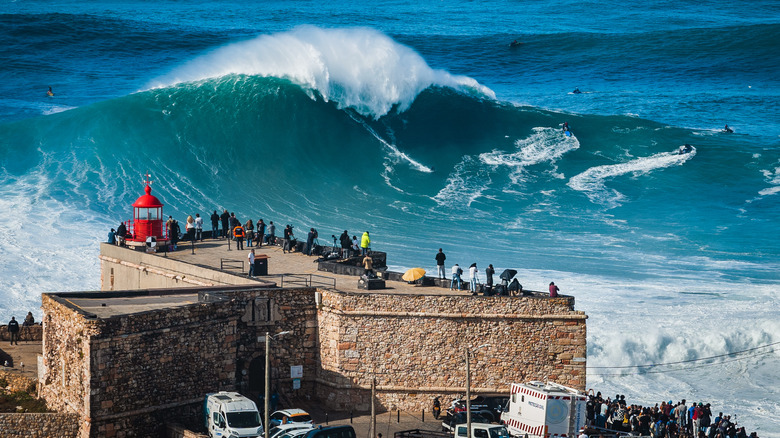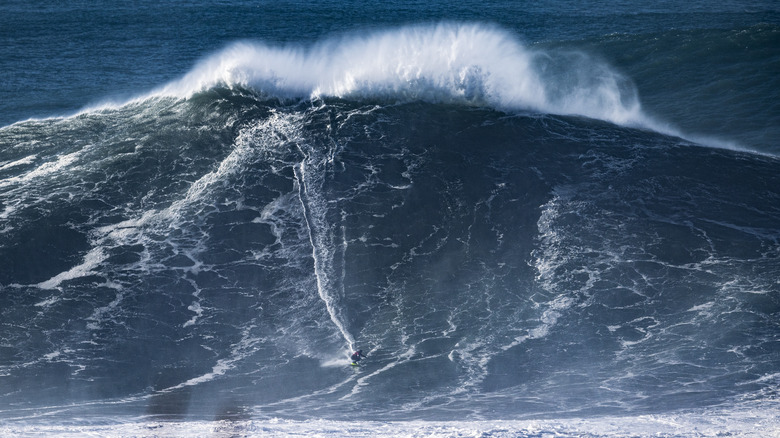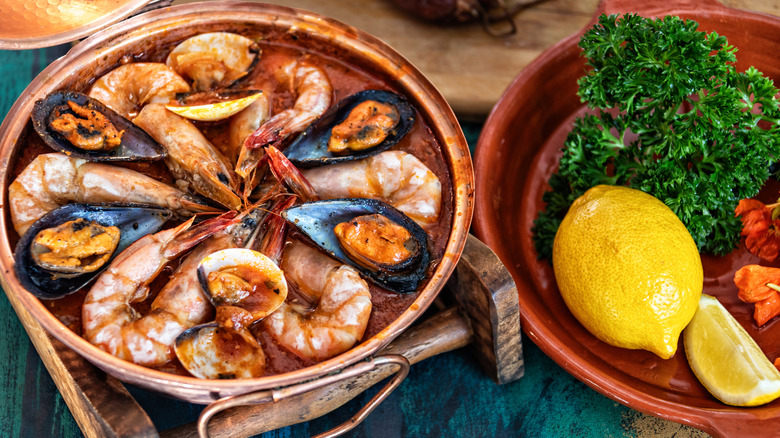The Record-Breaking Reason This Beach In Portugal Is One Of The World's Most Dangerous
Standing atop São Miguel Arcanjo fort, you watch a 50 to 100-foot-tall wave rear up out of the Atlantic Ocean, creating the illusion that it's about to overwhelm you with its might and menace. The winter waves at Praia do Norte (North Beach) in the little Portuguese fishing village of Nazaré are the biggest and fiercest in the world, and an international cadre of big wave surfers have turned the town into a competitive surf mecca where records are made to be broken.
North Beach, as it stretches off beyond the fort, may look inviting with its golden sands, gently rolling dunes, and cerulean waters. What you can't see is the underwater canyon that runs the length of the beach and causes the tsunami-sized waves those surfers love. Even when it appears calm, as it does in summer, you should not try to swim here, or even get too close to the sea, lest a sneaker wave sweep you out to a watery grave. Like this beach on Oahu that's nicknamed Broke Neck Beach, or this beach in Florida with treacherous rip currents lurking beneath a seemingly calm surface, some stretches of sand are better left on a postcard.
A fishing village turned surf town
Nazaré became famous in 2011 when Hawaiian surfer Garrett McNamara set a Guinness World Record for the tallest wave ever surfed, a whopping 78-footer. His record has since been broken, and that record too, as surfers chase higher and higher swells. Nazaré quickly became a top surf destination, both for pros and amateurs. The big waves dominate in winter, but at other times of the year, Nazaré is considered a good place to attend surf school, even for beginners. The World Surf League now holds an annual competition here.
But the risks are real: Brazilian surfer Maya Gabeira, who holds the women's world record, nearly drowned in 2013 but came back to surf the biggest wave of the year in 2020, by anyone, regardless of gender. (That's her surfing at North Beach in the image above). But after several more close calls over the years, Nazaré finally saw its first surfing fatality in 2023. It's hard to overstate the power of the forces at play. "Some of those waves are more like atomic bombs than waves," comments one Portuguese YouTube viewer on the trailer for the riveting HBO documentary series, "100 Foot Wave," which was filmed at this beach. The biggest waves, like those found here, can exert up to 6,000 pounds of pressure per square foot. For scale, that's the weight of a Super Duty Ford F-250 pickup truck — in a square foot.
A better way to approach the ocean in Nazaré
Nazaré has another oceanic distinction besides its monster waves, and that's the quality of its seafood. Portugal is on every foodie's bucket list, and Nazaré, on the country's legendary Silver Coast, was a fishing village long before it became a surf town. Tabernia d'Adélia, the only Nazaré restaurant in the Michelin Guide, has quirky, fun decor that includes model fishing boats and high-backed chairs in mismatched plaids. While it pays to be timid on the beach, don't be afraid to order adventurously here — try the shrimp, squid, and monkfish kebab, which arrives at your table as a tower, or an order of barnacles. Pangeia is the top-rated restaurant on Tripadvisor, and sits on a hill with the coastline spread out below. It's known for its octopus preparations. Octopus carpaccio? We'd surf a pretty big wave for a plate of that delightful delicacy.
We'd rather watch those waves break from the cozy warmth of Garret McNamara's favorite spot on dry land, Restaurante A Celeste. One of this beachfront gem's specialties is migas, a breadcrumb dish that's traditionally cooked in pork fat and is slightly reminiscent of Thanksgiving stuffing. Celeste is also one of the few local joints to offer a range of vegetarian meals, including a tasty version of migas, so you don't have to miss out on the experience. After indulging in such a carb-a-licious feast, you will no doubt begin to appreciate the importance of the siesta in parts of Portugal and Spain.


